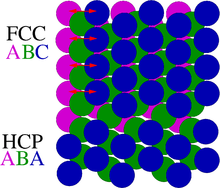Stack fault
A stacking fault is a 2-dimensional lattice fault in certain crystal structures . He occurs z. B. face-centered cubic crystal structure (FCC) in which a stack of crystal planes with the sequence ABCABC ... can be described. If this regularity is interrupted (e.g. ABCBCABC ... ), there is a stacking error. A local HCP grid structure with the stacking ABAB ... is usually formed here .
In general, stacking faults are most easily formed in the most closely packed crystal planes (e.g. (111) in the FCC crystal ), because this is where the interaction between the atoms is strongest. Furthermore, with the same reasoning, they grow the easiest in the most closely packed directions (e.g. (112) in the FCC crystal).
The stacking fault is an important lattice defect because it leads to the formation of grain boundaries and thus prevents the formation of single crystals . Stacking faults arise, for example, from the formation of twins or when a partial dislocation runs through the crystal. The smaller the required for this purpose stacking fault energy (SFE, stacking fault energy), the easier to form a stacking fault.
Silver has a low SFE:
Dislocations can therefore easily split into partial dislocations. Screw dislocations then have to constrict again with the expenditure of energy in order to slide sideways, which is why the strength increases .
The splitting width continues to play an important role in hot forming . Since split dislocations are difficult to slide or climb across, dynamic crystal recovery is hindered in materials with low stacking fault energy and stronger solidification of the metal takes place. A sufficiently large driving force can thus build up for dynamic recrystallization , which leads to a maximum force in the warm flow curve .
In pure iron , the SFE is:
in austenitic steels z. T. but
Therefore, only the latter show a TWIP effect .
Individual evidence
- ↑ Hermann Schumann: Influence of the stacking fault energy on the crystallographic lattice mechanism of the γ / α transformation in high-alloy steels . In: Kristall und Technik , Vol. 9 (1974), Heft 10, pp. 1141-1152, ISSN 0023-4753 doi : 10.1002 / crat . 19740091009 .



